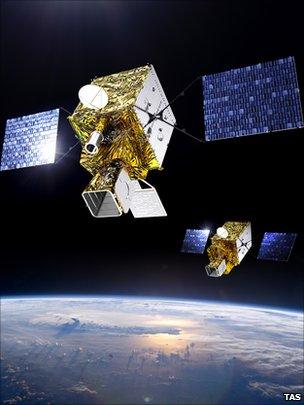Weather satellite work begins
- Published

MTG is a two-satellite system - an imaging and a sounding spacecraft
A contract has been signed that will finally allow an industrial consortium to begin work on a new generation of Meteosat weather spacecraft for Europe.
Six satellites will be built to give forecasters up-to-the-minute data on developing weather systems.
The R&D phase of the programme was approved by governments in 2008, but political wrangling delayed its start.
Thales Alenia Space (France) and OHB System (Germany) have now been told they can proceed with the work.
A contract initiating the detailed design of the spacecraft was signed between the companies and the European Space Agency (Esa), which will oversee the technical aspects of the programme.
Eumetsat, the international agency charged with looking after Europe's Meteosats, will operate the platforms when they get into orbit, scheduled to be from 2018.
"We are extremely happy and proud to meet the challenge of building the most ambitious geostationary satellites ever developed in Europe, and thank Esa and Eumetsat for their confidence," Reynald Seznec, president and CEO of Thales Alenia Space (TAS), said in a statement.
The initial contract covers about six months' work in which the consortium will establish its full team, including all its sub-contractors.
Esa, TAS and OHB sign the initial contract in Cannes, France
A full contract with Esa will then be penned in the middle of next year.
Meteosat Third Generation (MTG), as it is known, comprises two types of spacecraft: an imaging satellite to picture weather systems, and a sounding spacecraft (one that can return information about different layers in the atmosphere).
Four imaging spacecraft and two sounding satellites will be constructed. Their launch will be phased to maintain coverage through to about 2040.
The new spacecraft will be quite unlike their forebears. The second generation satellites (MSG), for example, are spin-stabilised and build up their images as they rotate across the field of view.
The MTG spacecraft will look more like standard telecommunications platforms. They will sit and stare at the Earth.
Their image data will have a much higher resolution (capturing details as small as 500m) and will come down in a fraction of the time - in as little as 2.5 minutes.
The Meteosat series stretches back to 1977. Currently, two platforms - Meteosat-8 and Meteosat-9 - provide the space data on which daily weather forecasts for Europe depend.
The total cost of MTG is likely to be on the order of 3.4bn euros, with some 2.4bn expected to come from Eumetsat member states and the remainder from Esa member states.
Eumetsat will hold a council meeting at the end of the month when it will try to approve its part of the programme.
It has taken much longer than expected to sort this out because Eumetsat has been waiting for arguments over the workshare in the satellite contract to be settled. With this now resolved, all the major Eumetsat nations have indicated they will wave the project through.
Some doubts remain, however, over the contributions of a number of smaller nations because of the economic crisis. Some may need more time to organise their finances.
At the last count, 17 of 25 Eumetsat members had indicated their desire to approve, representing more than 75% of the budget the organisation needs to put into MTG.
TAS said the consortium would have the first imaging MTG satellite ready for launch by the end of 2017 and the first sounder ready by the spring of 2019.
The manufacturing of the other spacecraft to go into storage will range from 2018 to 2021
All the imagers will be integrated at the TAS premises in Cannes, France; the sounders will be integrated at OHB premises in Bremen, Germany.
- Published21 June 2010
- Published29 May 2010